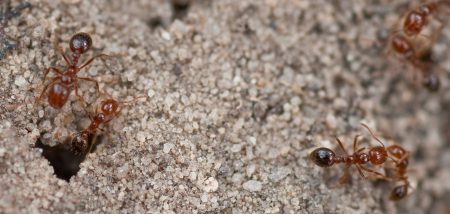The sweet smells of spring fill the air as more and more people head to parks and playgrounds to enjoy the weather. While the air grows warmer and the promise of summer quickly approaches, picnic-goers and adventure-seekers head outdoors, facing the risks that come with it – from sunburns and allergies to bee stings and ant bites.
Residents of the southeastern U.S. have learned keep a close eye out for soil mounds to avoid the painful stings of the red imported fire ant. Highly aggressive, the ants are often discovered by humans only after stepping on a mound.

Florida Museum photo by Jeff Gage
“Fire ants are very annoying pests, and they cause people to suffer,” said Marina Ascunce, a postdoctoral associate with the Florida Museum of Natural History on the University of Florida campus. “People who are allergic can die (from ant stings).”
A study published in Science Feb. 25, 2011, could prove helpful in controlling the prominent red imported fire ant, Solenopsis invicta. Ascunce co-authored the study with Chin-Cheng Yang of National Taiwan University and the results show the southeastern U.S. has been the source of recent red imported fire ant invasions around the world.
The ants have had a foothold in the U.S. for decades since their introduction through a port in Mobile, Ala. in the 1930s. They were contained in the southeastern U.S. for decades until about 10 years ago, when the global traders assisted its spread into faraway places, including Australia, California, China, New Zealand and Taiwan.
Scientists used several types of molecular genetic markers in the study to trace the origins of ants in nine locations where recent invasions occurred. Samples from 2,144 colonies at 75 geographic sites showed all the invasions could be traced to the southeastern U.S., with the exception of one instance when the ants moved from the southeastern U.S. to California, then to Taiwan.
“I thought that at least one of the populations in the newly invaded areas would have come from South America, but all of the genetic data suggest the most likely source in virtually every case was the southern U.S.,” Ascunce said.
Fire ants live in colonies with at least one queen, who can live from two to seven years and lay about 1,500 to 5,000 eggs a day. A typical colony consists of about 80,000 workers and mature colonies may house more than 200,000 workers.
In addition to the immediate frustration their stings cause to humans, the red imported fire ant costs Americans about $6 billion a year to control and offset damages, including medical costs, and they inflict about $750 million a year in agricultural losses.
Because they are easily transported in commerce, the ants threaten to invade other temperate regions in the world with sufficient rainfall and have the potential to take over half the land in the world.
Collecting data
Much of the data for the research depended on collections from international collaborators. Study co-authors include DeWayne Shoemaker, a USDA scientist affiliated with UF’s Institute of Food and Agricultural Sciences; Cheng-Jen Shih and Wen-Jer Wu, both of National Taiwan University; Jane Oakey of Biosecurity Queensland, Australia; Luis Calcaterra of the USDA-ARS South American Biological Control Laboratory in Argentina; Jérôme Goudet, of the University of Lausanne in Switzerland and Kenneth Ross of the University of Georgia.

Florida Museum photo by Jeff Gage
Samples were collected from South America and the southeastern U.S. as well as all the known newly invaded areas, including Australia, California, China, Hong Kong, Macao and Taiwan. In the U.S., samples were gathered from Florida, Georgia, Louisiana, Mississippi, Texas and Virginia.
Ascunce began working on the Solenopsis invicta project as a postdoctoral fellow at the Gainesville branch of the U.S. Department of Agriculture in 2007.
In December 2007, she traveled to Bolivia to collect specimens of the fire ant with Mike Heaney, a graduate assistant in the Florida Museum division of molecular systematics and evolutionary genetics. In Bolivia, they met Luis Calcaterra, one of the study co-authors, as well as Julieta Ledezma and Maria Luz Quispe of the Museo de Historia Natural Noel Kempff Mercado, Santa Cruz de la Sierra, Bolivia.
“You use a shovel to dig down and try to get the queen,” Heaney said. “You shovel a nest into the bin and sift all the ants out with tweezers, then put them into an alcohol vial for DNA.”
Fire ants are omnivorous, but their primary source of food consists of insects and other invertebrates. But in recent years, there have been reported cases of attacks on vertebrates, including bird and reptile hatchlings, gopher tortoises and even humans.
The swollen red bumps caused by ant bites last for days and in some cases, allergic reactions can be fatal.
Slowing the spread
Imported fire ants currently infest more than 310 million acres of land in the U.S. and Puerto Rico. With their small size, they can travel undetected by means of cargo, dirt used for construction or the luggage of travelers.

Photo by Jeff Gage
Finding effective methods for eradicating the red imported fire ant has been a challenge for decades. Insecticide sprays are used to kill worker ants, but if the queen survives deep within her chamber, the colony will survive and repopulate.
“If you can narrow down the source population, you can look for its natural enemies in that area, and hopefully they would be more specific and more efficient against the fire ants here,” Ascunce said. “If you know the fire ants were coming from northeastern Argentina, it wouldn’t make sense to look for natural enemies even in Brazil, for example.”
One natural enemy of fire ants used to control their spread is the phorid fly. The insect hovers over a mound before injecting an egg into an ant. When the egg hatches, the maggot develops within the ant’s head, eventually decapitating the ant and turning into a fly.
As global trading expands, the spread of the red invasive fire ant will continue to threaten agriculture, wildlife and human health and safety.
“The U.S. is known to have a high amount of trade worldwide with a lot of countries, so it is more likely to spread invasive species, as well as receive invaders from elsewhere,” Ascunce said.